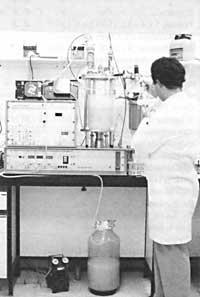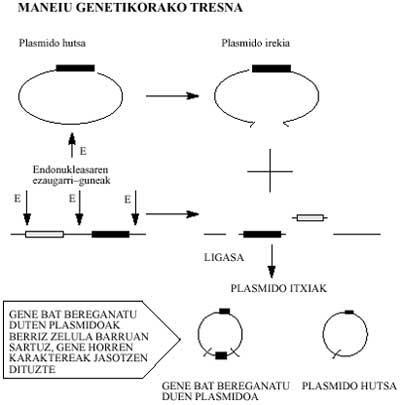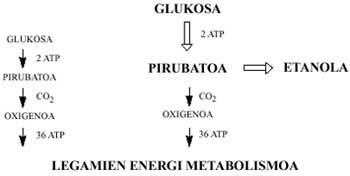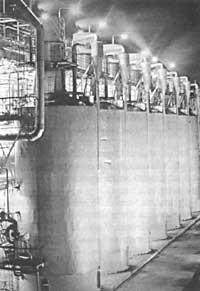Genetic management and new industrial processes
1990/11/01 Ugalde, U.O. | Dickson, R.C. Iturria: Elhuyar aldizkaria
Biotechnological processes

The benefits that human beings have obtained through biological processes have always generated a special interest in society, both for its mystery and its artisanal character. These discoveries are based on the analysis of the results of common natural phenomena. Therefore, human beings have not "produced" these processes, but have managed the natural conditions for these processes to occur by themselves or rather naturally.
It is said that the discovery of beer occurred when the Phoenicians transported the flour in large containers and realized that when the flour was wet a series of processes were produced and alcohol (beer) was produced. It was the work of Leaven. The initial discovery has been manipulated over the years until we reach the process we know today. Barley feels alert, that is, it "melts", releasing more sugar before yeast fermentation.
Other biological transformation processes such as cheese, wine and antibiotics have evolved in parallel.
In all these processes two distinct elements must be clearly differentiated: the medium or substrate and the microorganism that has produced the alteration.
The medium needs the right chemical components for its assimilation and transformation. Its concentration, temperature, pH, etc. have a fundamental influence on the progress of the process. On the other hand, the microorganism can be considered a very complex catalyst, coordinating a large group of reactions. The potential of the microorganism is very variable and depends on the reaction conditions.
We can put as an example the case of the aforementioned beer. The presence or absence of oxygen during the process conditions the final result to be obtained, that is, if the yeast produces a synthesis of cellulosic material or alcohol.
Taking into account these two main elements (the medium and the microorganism), and despite the great complexity of one of them, man has managed to dominate biological processes. However, although the human being has known how to perform microbiology, he has collected these processes with great mystery and has not known until recently why and the core of them.
Throughout this century, many mysteries about these organisms have been discovered. Reactions at the base of energy metabolisms were diluted in the 1930s. In 1940, the chemical nature of the molecule and the cellular information it contains, called DNA, were discovered. Subsequently, the genetic code and its mechanism of return to cellular functions were soon deciphered. We are still far from knowing exactly the complexity of this cellular function, but it is true that the human being is taking great and rapid steps to achieve that spectacular goal.

Management path
No more than fifteen years ago, bacterial enzymes were discovered to selectively cut very specific DNA sequences. It was a system to defend against the viruses they attack. Each bacteria has a lot of enzymes, known as cutting endonuclease as the immune system.
Outside of these findings are enzymes capable of binding and repairing the affected DNA parts. These enzymes are called ligases.
Another of the findings of great importance has been that of the plasmids. These are round fragments of DNA that, apart from chromosomes, are found in groups within the cell. Therefore, not being in the nucleus is called satellite DNA.
Cutting endonucleases, ligases and plasmids are three basic tools for the genetic management of an organism.
The DNA of an organism, through a cutting endonuclease, can be divided into small fragments. The number of fragments will depend on the sequences of 4-6 bases known for each type of enzyme. If the parts are long enough, they may contain one or more genes.
Just as endonuclease is capable of fragmenting DNA, a circular plasmid can "open up" and become linear DNA, but adding a ligase can "close" that DNA again, reforming the circular structure of the plasmid. If this plasmid repair occurred in front of the parts of DNA that we mentioned in the last paragraph, some plasmids would be closed by the uptake of one or more parts of linear DNA and therefore their genes. By introducing this new plasmid into the cell, you can highlight the new gene it contains, adding a new function firmly to the cell.
Through this technique it is possible to give new characteristics to organisms of industrial interest. Finally, although only theoretically, we can affirm that at present we can control the physiological process, both through external conditions and through the functional potential of the organism we use.

An industrial process
Five years ago we started in Donostia the production of cellular protein from whey milk. This by-product is generated in the cheese making process. Being very polluting poses problems.
Our goal was to achieve a high protein biomass by generating different yeasts that consume whey lactose. But we soon encounter a major problem.
Yeast increase is related to the energy generated in your metabolism. Therefore, this energy can be invested in the manufacture of cellular material, that is, in its growth.
The molecule that serves to transfer this energy from the place of generation to final consumption is ATP.
When the sugar molecule (glucose) enters the cell, a chain of 10 reactions is followed that oxidizes forming two molecules of pyruvic acid and two of ATP. If the cell contains oxygen, the pyruvic acid continues to oxidize until it gives CO 2 and generates 36 other ATP molecules. If you do not have oxygen, pyruvate will not rust. It is reduced to produce ethanol (Remember the beer process).
From what we have said before, the reader can conclude that the cells when they carry oxygen take better advantage than when they are missing, and therefore grow more. This forces us to design fermentation reactors with forced ventilation to produce yeast.

However, also in the presence of oxygen we have seen that serum fermentation produces alcohol. When we defined the study, we found that in high serum sugar concentrations (40-60 g l -1), the first reaction produces pyruvate at high speed. This pyruvate production flow is very high compared to that consumed by oxygen-containing reactions, which produces an "overflow" effect when alcohol is produced as an addition.
In this problem we apply a simple solution: we dilute the serum to reduce the sugar concentration. Today we have mathematical models to feed the reactor with serum and we have had good consequences. However, there is another possibility, which is also more beneficial from a practical and scientific point of view.
Before metabolizing inside the cell, serum sugar is transported inside by a special protein called permease.
The lactose transport system with permease increases its capacity as the sugar concentration increases, so high concentrations of sugar are added permease molecules to transport lactose inside the cell. This is the overflow effect of the pyruvate mentioned above. The lactose permease gene has been isolated and one of our sequences (R. C. Dickson) has decrypted it. Our next goal is to introduce some changes: to manage the synthesis of the permease molecule (to give a lower response with other sugar uptake, avoiding the overflow effect) outside the sugar collection carried by the serum. Once this goal is achieved, we will enter into the yeast so that the new gene will prevail and not yours.
In this way we will achieve a large amount of protein-rich biomass, avoiding conventional mechanisms and using a specific type of control of the microorganism. Undoubtedly, we are at the beginning of the new designs of biotechnological processes, and from here will emerge interesting novelties and a lot of information of great value for the future.

Gai honi buruzko eduki gehiago
Elhuyarrek garatutako teknologia



